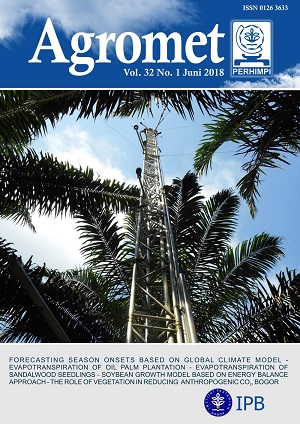Evapotranspiration of Sandalwood (Santalum Album L.) Seedlings with Several Primary Host Plants
Abstract
Sandalwood (Santalum album L.) seedlings planted with different primary host plants should require different amounts of water. In practice, however, sandalwood seedlings with different primary host plants are irrigated with similar amount of water. Thus, it is interesting to study the amount of water expressed as evapotranspiration for the sandalwood seedlings and their primary host plants because there are hemiparasitic symbiosis plants in one planting medium. The purpose of this research was to compare and analyse evapotranspiration (ET) and water use efficiency (WUE) of sandalwood seedlings with different primary host plants, namely chili (Capsicum annum), krokot (Alternanthera sp.), and sengon (Albizia chinensis). The experiment was conducted in a greenhouse and designed using completely randomized design. Results showed that different primary host plants already influenced ET at 6 days after sowing of primary host (DASH). The sandalwood seedlings with chili and krokot as primary hosts, had the highest ET during 6-22 DASH. From 24 to 36 DASH, ET for all types of host plants were similar. After 36 DASH, ET of sandalwood seeding with primary host sengon increased, and had the highest ET. Sandalwood seedling with primary host krokot had the highest WUE to produce sandalwood above ground biomass with value 0.3 g/l during the 0-3 weeks after sowing of primary host (WASH), 0.6 g/l during the 3-6 WASH, and 0.9 g/l during 6-9 WASH.

